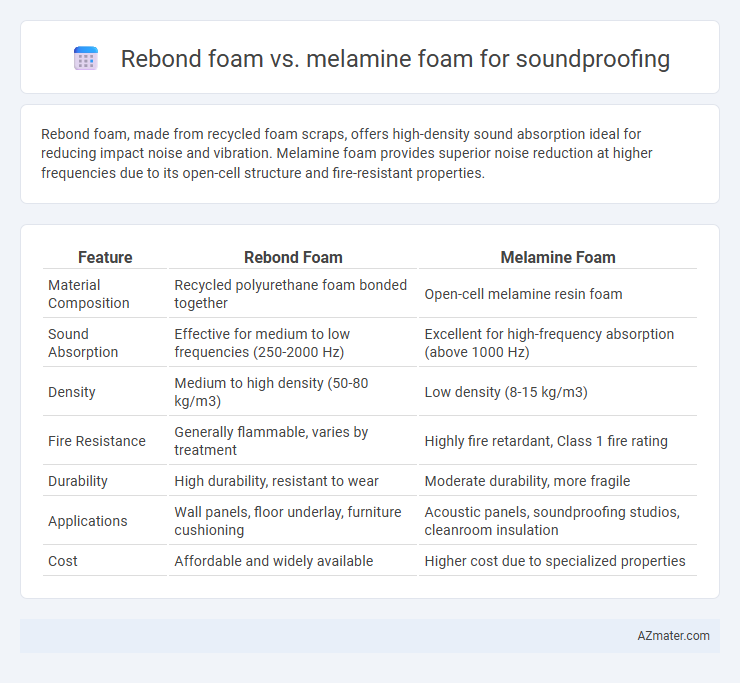Rebond foam, made from recycled foam scraps, offers high-density sound absorption ideal for reducing impact noise and vibration. Melamine foam provides superior noise reduction at higher frequencies due to its open-cell structure and fire-resistant properties.
Table of Comparison
| Feature | Rebond Foam | Melamine Foam |
|---|---|---|
| Material Composition | Recycled polyurethane foam bonded together | Open-cell melamine resin foam |
| Sound Absorption | Effective for medium to low frequencies (250-2000 Hz) | Excellent for high-frequency absorption (above 1000 Hz) |
| Density | Medium to high density (50-80 kg/m3) | Low density (8-15 kg/m3) |
| Fire Resistance | Generally flammable, varies by treatment | Highly fire retardant, Class 1 fire rating |
| Durability | High durability, resistant to wear | Moderate durability, more fragile |
| Applications | Wall panels, floor underlay, furniture cushioning | Acoustic panels, soundproofing studios, cleanroom insulation |
| Cost | Affordable and widely available | Higher cost due to specialized properties |
Introduction to Rebond Foam and Melamine Foam
Rebond foam, made from shredded and reprocessed polyurethane foam bonded together, offers high density and durability, making it effective for sound absorption in industrial and commercial applications. Melamine foam, a lightweight, open-cell foam derived from a thermosetting resin, excels in noise reduction by trapping sound waves within its fine, porous structure, often utilized in studios and residential spaces. Both materials provide versatile acoustic solutions, with rebond foam emphasizing impact resistance and melamine foam focusing on high-frequency noise attenuation.
Key Properties of Rebond Foam
Rebond foam, made from shredded polyurethane scraps bonded together, offers superior durability and high-density acoustic insulation compared to melamine foam. Its open-cell structure effectively absorbs mid to low-frequency sounds, making it ideal for soundproofing applications in studios and industrial settings. The resilience and compressive strength of rebond foam provide long-term performance under heavy compression and repeated use.
Key Properties of Melamine Foam
Melamine foam is highly valued for soundproofing due to its open-cell structure, excellent acoustic absorption, and thermal resistance, making it effective at reducing mid to high-frequency noise. Its lightweight, fire-retardant, and non-toxic properties enhance safety and usability in various environments. Compared to rebond foam, melamine foam offers superior ease of installation and better long-term durability under fluctuating temperature and humidity conditions.
Acoustic Performance Comparison
Rebond foam offers superior acoustic absorption across low to mid frequencies due to its dense and porous structure, making it effective for reducing echo and reverberation in enclosed spaces. Melamine foam excels at high-frequency sound absorption because of its open-cell microstructure that traps sound waves efficiently, resulting in improved clarity and noise reduction in applications like recording studios. Comparing acoustic performance, rebond foam is ideal for broad-spectrum noise control, while melamine foam targets precise high-frequency attenuation for optimal soundproofing.
Durability and Lifespan
Rebond foam offers superior durability and a longer lifespan compared to melamine foam due to its dense composition made from recycled polyurethane foam scraps. Melamine foam, while effective for sound absorption and fire resistance, tends to be more fragile and susceptible to crumbling or degradation over time, especially under heavy use or exposure to moisture. For long-term soundproofing applications requiring resilience, rebond foam provides better structural integrity and maintains acoustic performance more effectively.
Fire Resistance and Safety
Rebond foam and melamine foam differ significantly in fire resistance and safety for soundproofing applications. Melamine foam is inherently fire-resistant, self-extinguishing, and meets stringent fire safety standards, making it ideal for environments requiring high fire safety. Rebond foam, composed of recycled polyurethane, is less fire-resistant and typically requires additional fire retardant treatments to comply with safety regulations.
Ease of Installation
Rebond foam offers superior ease of installation due to its flexible composition and availability in large, easily cut panels or tiles, making it ideal for quick application on walls and floors. Melamine foam, while lightweight and fire-resistant, typically requires precise cutting and careful handling to prevent crumbling, which can complicate the installation process. Both materials benefit from adhesive backing options, but rebond foam's durability and compressibility often lead to faster, more forgiving installation in soundproofing projects.
Cost Comparison
Rebond foam typically costs between $1 to $3 per square foot, making it a budget-friendly option for soundproofing projects, while melamine foam ranges from $4 to $8 per square foot due to its superior acoustic performance and fire-resistant properties. The lower density and open-cell structure of rebond foam contribute to its affordability but may compromise sound absorption efficiency compared to the rigid, open-cell composition of melamine foam. For large-scale applications requiring high noise reduction and fire safety compliance, the higher investment in melamine foam often justifies the cost despite the initial price difference.
Best Applications for Each Foam
Rebond foam excels in soundproofing for high-impact noise areas such as gym floors and industrial settings due to its density and durability, effectively absorbing bass frequencies and vibrations. Melamine foam is ideal for acoustic treatment in residential and office environments, providing excellent mid- to high-frequency sound absorption while being lightweight and fire-resistant. Choosing between rebond and melamine foam depends on specific soundproofing needs, with rebond suited for heavy-duty noise control and melamine preferred for improved room acoustics and speech clarity.
Conclusion: Which Foam is Better for Soundproofing?
Rebond foam offers superior sound absorption due to its dense, open-cell structure that effectively reduces mid to low-frequency noise, making it ideal for soundproofing environments like studios and theaters. Melamine foam excels in high-frequency sound absorption and fire resistance but lacks the mass and density required for broader soundproofing applications. For comprehensive noise control, rebond foam is generally the better choice because of its enhanced acoustic insulation properties and durability.

Infographic: Rebond foam vs Melamine foam for Soundproofing
 azmater.com
azmater.com